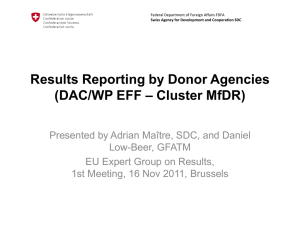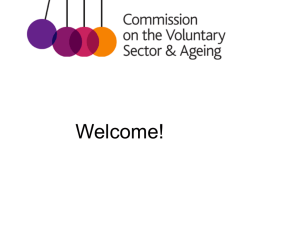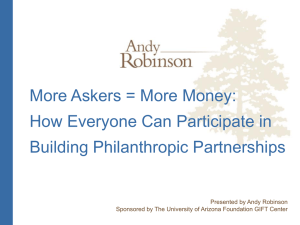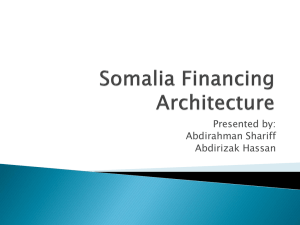Driving Donor Loyalty
advertisement
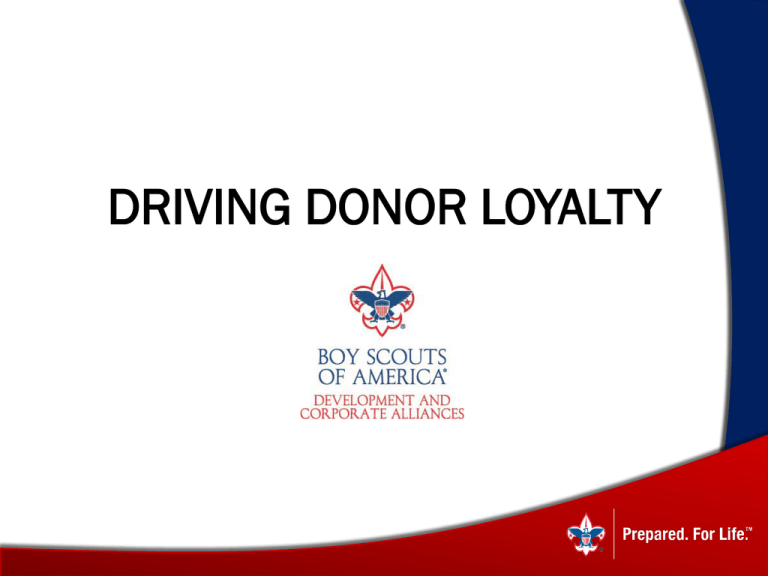
DRIVING DONOR LOYALTY Donor Retention Process not a Project Commitment Retention Versus Loyalty How do they relate? Retain 1. to keep possession of. 2. to continue to use, practice, etc.: to retain an old custom. 3. to continue to hold or have. 4. to keep in mind; remember. 5. to hold in place or position. Loyalty [implies] a sense of duty or of devoted attachment to something or someone. Loyalty connotes sentiment and the feeling of devotion that one holds for one’s country, creed, family, friends, etc…implies unwavering devotion and allegiance to a person, principle, etc. Who Are We Loyal To? Who Are We Loyal To? alma maters college sports professional sports friends and family movie & television stars our faith political parties Who Are We Loyal To? Who Are We Loyal To? alma maters college sports Professional sports friends and family movie & television stars our faith political parties Retention Versus Loyalty Constituents have multi-faceted relationships with your council Thought key, donating is only one way a constituent can interact Look for missionaries not just transactional behaviors Life-time value is not calculated year over year Donor retention is only one measure of loyalty Donor Demographics Boom, Bust, and Echo Understanding of basic demographic dynamics can explain most of the current patterns we observe in consumer behavior. Donation is a purchase Why? Everyone ages As we age, we enter into life-cycle phases that govern our attitudes, careers, and discretionary income spending habits Donor Demographics Baby Boomers—the Boom General Description Born between 1947 and 1966 The “me” generation will start to shift focus to its legacy Less willing to comparison shop, they seek quality and high level of service “Baby-boomers are human beings, not a new species. Previous generations also had their own popular music and they too learned to appreciate classical music” (Boom, Bust, and Echo) Volunteerism should increase as relatively healthy individuals leave the workforce Continuing education becomes a focus Communication Focus Legacy and leaving the world a better place Financial planning Donor Demographics Generation X—the Bust General Description Born between 1967 and 1979 Fewer in numbers, also having fewer children themselves First generation to have a lower quality of life than the one before Estimated that this generation will have on average three complete careers More action rather than idea oriented Communication Focus This age cohort is more cynical and less idealistic; they seek authenticity Return on investment is more psychic than material—don’t dwell on benefits Want “proof” of monies well spent Well positioned to be the most loyal group in decades… will have “pet” causes Donor Demographics Generation Y—the Echo General Description: Born between 1980 and 1994 Never knew a time before MTV and 50+ television channels Least religious of all prior generations Not a rebellious group—seldom had limits to start with Young Cosmopolitans (“Yo-Co’s”) much sought after but offer little loyalty Communication Focus: Very visual, prefer multi-media Able to consume vast amounts of information Very short attention spans Evaluating Loyalty Institutional mission and objectives What is your council’s mission What are your long-term objectives What are you short-term objectives How do you measure success Why should donors support you Evaluating Loyalty Environmental/Competitors Who is raising money from your donors? What are their activities How are they doing What are their strategies What are their strengths What are their weaknesses Is there anything you can learn from them Do they attract all of your donors or just particular segments o If yes, which segment(s) Evaluating Loyalty Donor Analysis Who are your donors? o o o o o Age range Gender Socio/economic factors Education Interests/Activities Why do your donors support you Do your mid to high-range donors differ from broad-based donors What characteristics do they share Why do these donors support you Of the two groups, who has a higher retention rate What do donors like about your institution What aspects of your mission create the most interest Evaluating Loyalty Donor Analysis (continued) What kinds of communication do your donors want Are there gaps Are you overwhelming your donors with communications What is the ratio of pure information to asks (both soft and direct) What other nonprofits do your donors support Why do they support them How do they decide “what portion of the pie” they give to you What prompts your donors to start giving Why do they stop Evaluating Loyalty Donor Relations How do you identify new donors Do you segment your database What criteria do you use for segmentation Can this be further refined What is the annual attrition rate for each segment Does one perform significantly better o If yes, why What types of donor acquisition work Evaluating Loyalty Based on the evaluation of your retention activities What are your strengths o How would you rank them What are your weaknesses o How do they fit into the following buckets o Fully resolvable in 0-6 months o Significant action taken within the year o Long-term planning required What are your goals for donor retention Percentage retained year over year Dollars raised from retention activities Which segments will produce these results Costs for retention programs How will you define success? Headquarters City Givers '12 $ PD '12 # PD '11 NR $ PD '11 NR # 10, 09, 08 $ 10, 09, 08 Council A 1,603 314,635 567 61,883 1,234 147,024 Council B 1,443 524,089 675 121,920 1,165 162,539 Council C 454 157,849 199 45,259 208 27,559 Council D 777 232,167 487 109,809 731 130,707 Council E 1,041 501,898 398 102,928 689 171,396 Council F 1,120 483,491 508 135,282 247 60,479 Council G 652 230,553 162 33,641 200 37,414 Council H 1,324 555,052 844 180,048 543 193,109 Council I 1,143 312,690 563 133,378 922 172,376 Council J 697 265,358 346 70,160 416 72,717 Council K 1,493 344,912 296 54,395 362 95,375 Council L 859 406,265 284 56,228 377 85,734 What are the possible reasons why we’re not retaining these donors? Reasons for Quitting No longer able to afford support No memory of ever supporting! Still supporting by other means Feeling that other causes are more deserving X no longer needs my support Relocated Not reminded to give again X did not inform me how my monies were used X’s communications were inappropriate X asked for inappropriate sums What are specific things we can do to better retain our 2012 donors in 2013? Survey says… Shocking BSA Statistics A 2012 BSA survey revealed: Slightly more than half of all councils (55 percent) have a written overall fundraising/development plan with timelines and goals. Only 43 percent of councils have a systematic, year-round approach to cultivating donor relationships. 25 percent of councils report they don’t have a development plan or an approach to cultivating donor relationships! Donor Communication Is Infrequent and Self-centered A 2012 BSA council survey revealed: 23.5 percent have board members call donors to thank them 35.3 percent send a donor targeted newsletter 59.5 percent send a holiday card 60.1 percent mail an annual report Some councils reported doing NOTHING to reach out to donors. Our communication focuses on what the COUNCIL has done with the money, not on how the DONOR has made an impact on lives. Most Councils Do Not Hold Donor Cultivation Events Only 47 percent of councils conducted a donor cultivation event in 2011. These events included: Recognition meals Heritage Society receptions Camp visits and open houses Major gift dinners/receptions It’s all about the donors Video located at http://www.youtube.com/watch?v=_Zs7mSHrDKA&feature=play er_detailpage Building Relationships Is Important Improves donor retention Leads to higher giving levels Creates higher long-term value Increased involvement Leads to long-term donor loyalty and legacies Retain Your Donors It is easier to keep a donor than find a new one. Build long-term relationships by maintaining regular communication. Don’t focus on the one-time gift; look for continued support. Donor Communication Plans Long term Annual Calendarized Specific Goals for targeted groups o Community at large o Scouting Family Major Donor Strategies Highly personal Meet as many as you can Personalized proposals Regular contact person from the council Volunteer and Pro partnership Major Donors Once you go personal, you can’t go back, move carefully Labor intensive and takes time The more individual the strategy, the better the results Walk Before You Run… Phase in gradually Helps you better evaluate results Improve annually You get better with practice Donor feedback will help you determine you next steps If You Can’t Do It All… Start small with five donors What could you do with five key donors this month? Next month? Start small…but do get started Success will breed success Video located at http://www.youtube.com/watch?feature=player_detailpage&v=go 0kWpHJGqM

